Abstract
A component present in several sera interacts selectively with the 5S "nuclear" form of estradiol receptor but not with the 4S "cytosol" form. This component is therefore referred to as "5S-complexing activity (5S-CA)." This selective interaction occurs with 5S receptor from mouse, calf, or rat. In addition, 5S-CA recognizes the nuclear form of the receptor from hypothalamic as well as uterine tissue Thus, 5S-CA indicates a general similarity in the chemical nature of 5S nuclear receptors prepared from several sources. Using 5S-CA as a chemical probe for the nuclear form of the estradiol receptor, I have shown the chemical as well as physical similarity of 5S receptors prepared in vivo (by injection of [3H]estradiol and subsequent isolation from nuclear/myofibrillar extracts) and in vitro (by labeling of cytoplasmic extracts and subsequent chromatography on columns of DNA-cellulose). These results indicate a distinctive chemical property of nuclear 5S forms of estradiol receptor. The data are interpreted with regard to models for 5S receptor formation. 5S-CA was found in sera from animals immunized against various antigens. The importance of testing for 5S-CA in antisera directed against steroid derivatives, steroid receptors, and other steroid-binding proteins is discussed.
Full text
PDF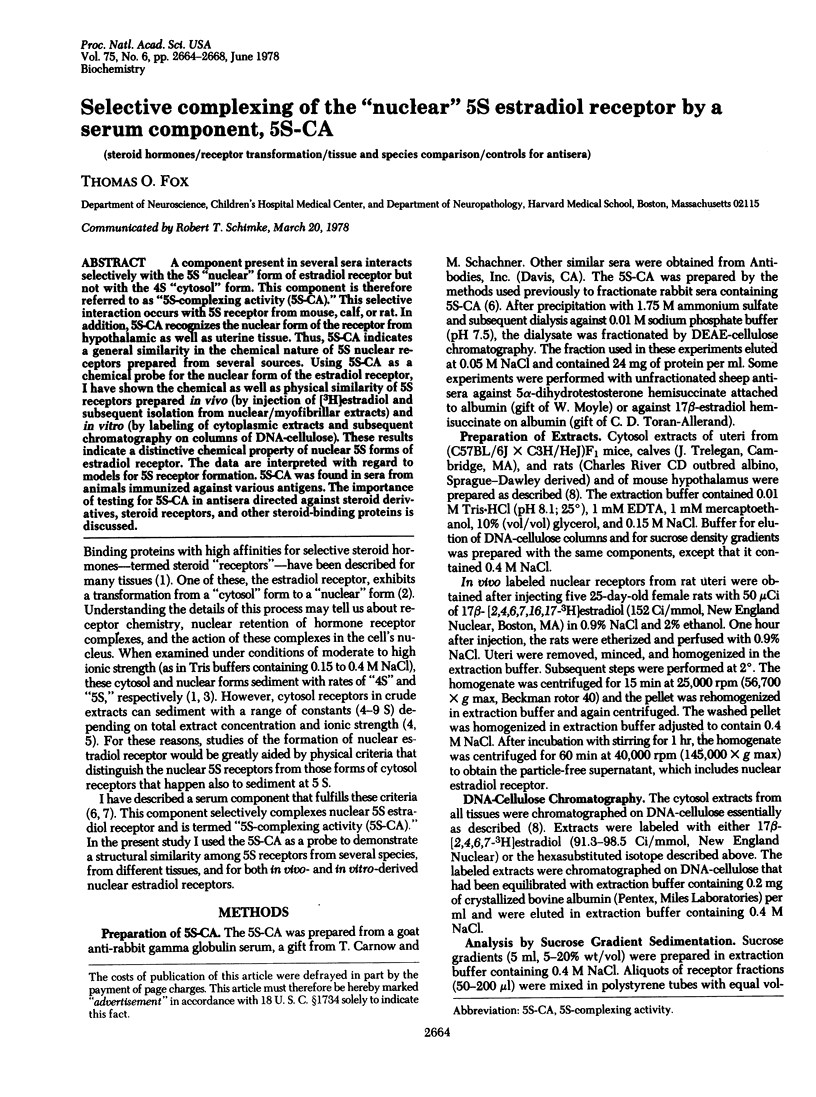
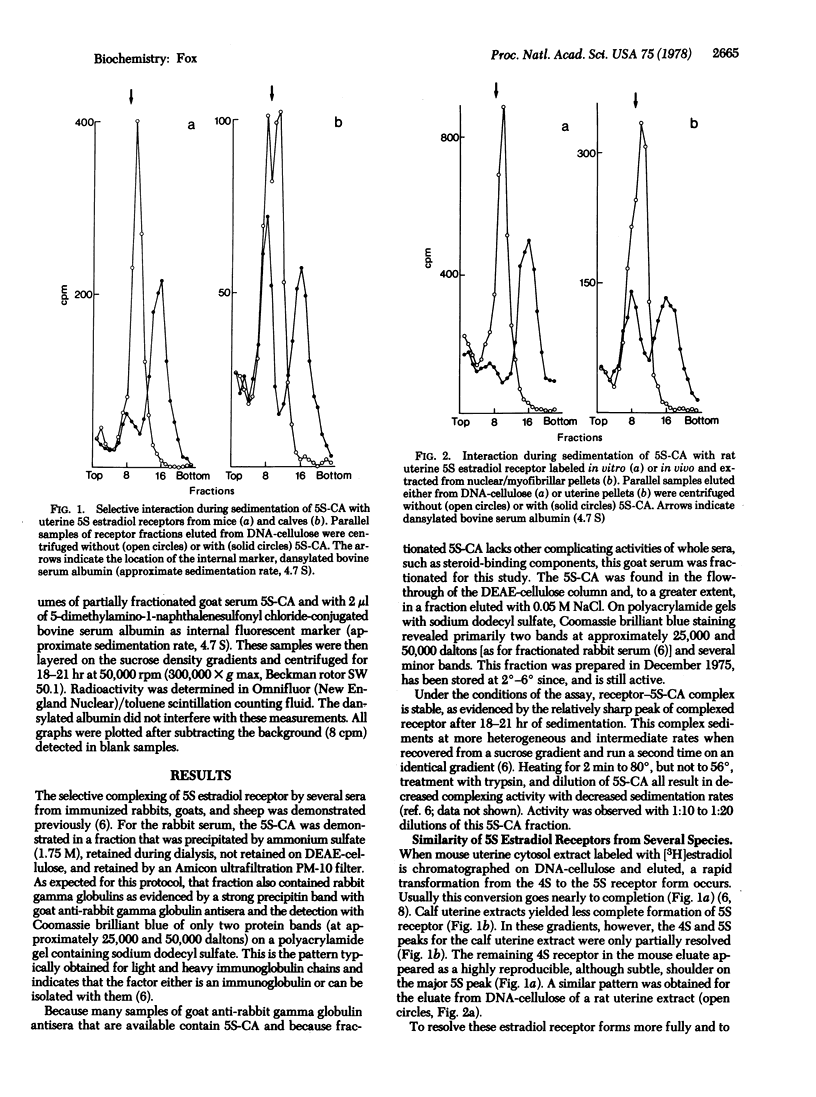
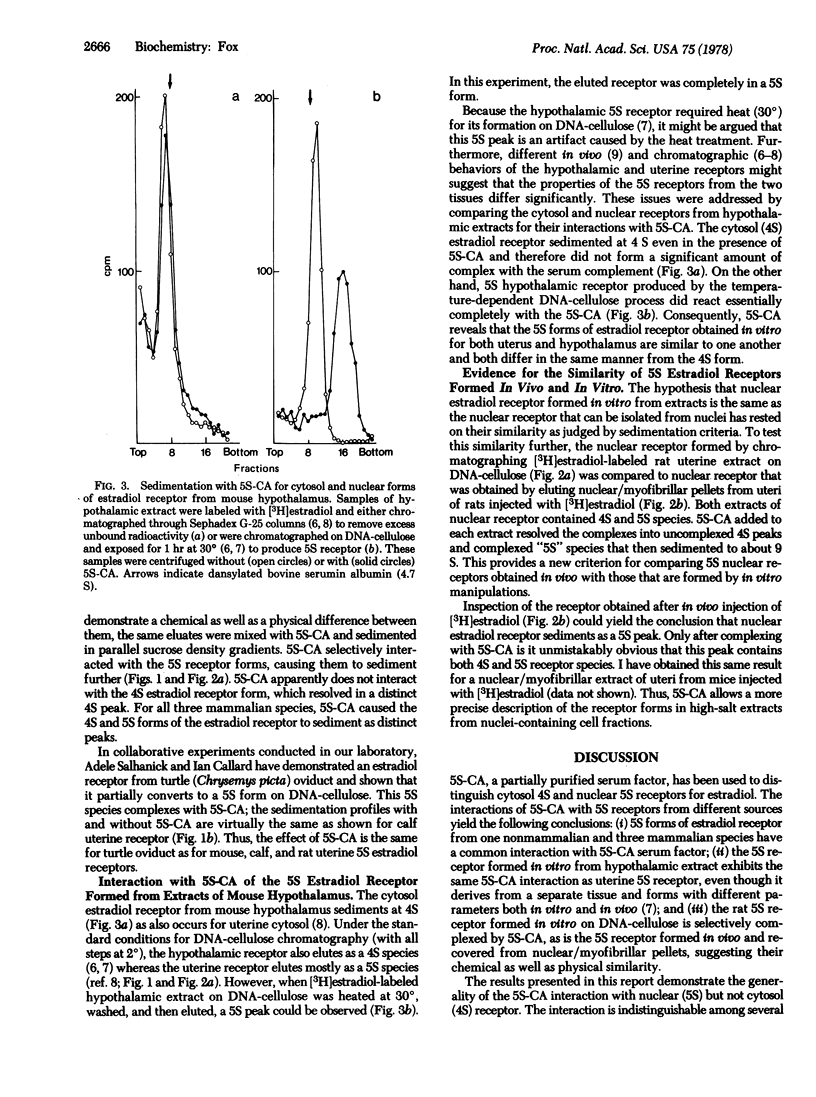
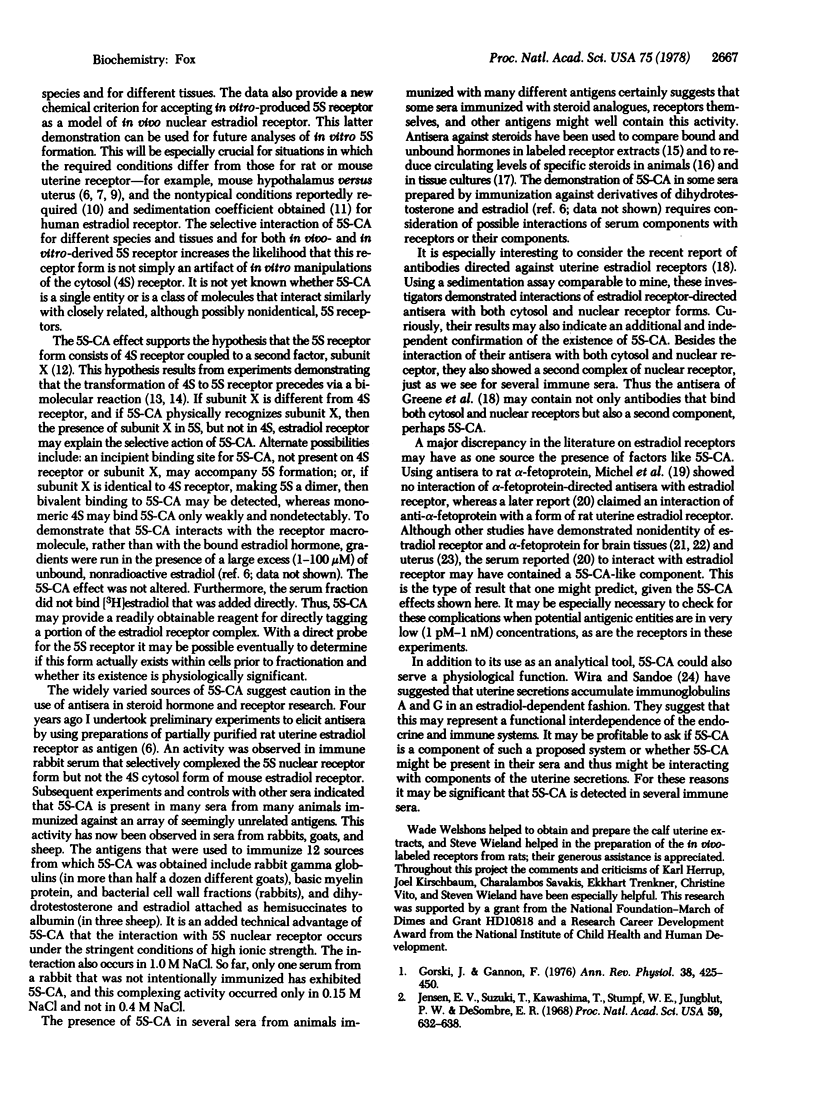
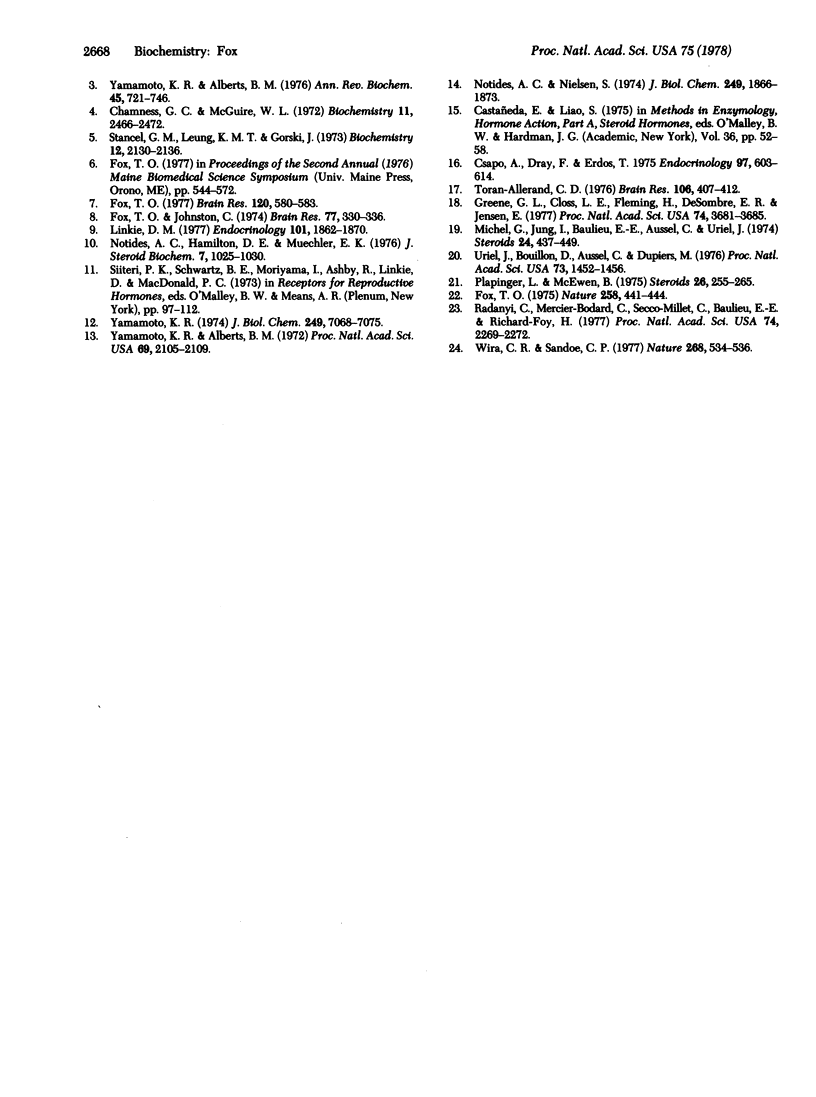
Selected References
These references are in PubMed. This may not be the complete list of references from this article.
- Chamness G. C., McGuire W. L. Estrogen receptor in the rat uterus. Physiological forms and artifacts. Biochemistry. 1972 Jun 20;11(13):2466–2472. doi: 10.1021/bi00763a013. [DOI] [PubMed] [Google Scholar]
- Csapo A., Dray F., Erdos T. The biological effects of injected antibodies to estradiol-17 beta and to progesterone in pregnant rats. Endocrinology. 1975 Sep;97(3):603–614. doi: 10.1210/endo-97-3-603. [DOI] [PubMed] [Google Scholar]
- Fox T. O. Conversion of the hypothalamic estradiol receptor to the "nuclear" form. Brain Res. 1977 Jan 28;120(3):580–583. doi: 10.1016/0006-8993(77)90414-0. [DOI] [PubMed] [Google Scholar]
- Fox T. O., Johnston C. Estradiol receptors from mouse brain and uterus: binding to DNA. Brain Res. 1974 Sep 6;77(2):330–337. doi: 10.1016/0006-8993(74)90797-5. [DOI] [PubMed] [Google Scholar]
- Fox T. O. Oestradiol receptor of neonatal mouse brain. Nature. 1975 Dec 4;258(5534):441–444. doi: 10.1038/258441a0. [DOI] [PubMed] [Google Scholar]
- Gorski J., Gannon F. Current models of steroid hormone action: a critique. Annu Rev Physiol. 1976;38:425–450. doi: 10.1146/annurev.ph.38.030176.002233. [DOI] [PubMed] [Google Scholar]
- Greene G. L., Closs L. E., Fleming H., DeSombre E. R., Jensen E. V. Antibodies to estrogen receptor: immunochemical similarity of estrophilin from various mammalian species. Proc Natl Acad Sci U S A. 1977 Sep;74(9):3681–3685. doi: 10.1073/pnas.74.9.3681. [DOI] [PMC free article] [PubMed] [Google Scholar]
- Jensen E. V., Suzuki T., Kawashima T., Stumpf W. E., Jungblut P. W., DeSombre E. R. A two-step mechanism for the interaction of estradiol with rat uterus. Proc Natl Acad Sci U S A. 1968 Feb;59(2):632–638. doi: 10.1073/pnas.59.2.632. [DOI] [PMC free article] [PubMed] [Google Scholar]
- Linkie D. M. Estrogen receptors in different target tissues: similarities of form--dissimilarities of transformation. Endocrinology. 1977 Dec;101(6):1862–1870. doi: 10.1210/endo-101-6-1862. [DOI] [PubMed] [Google Scholar]
- Michel G., Jung I., Baulieu E. E., Aussel C., Uriel J. Two high affinity estrogen binding proteins of different specificity in the immature rat uterus cytosol. Steroids. 1974 Oct;24(4):437–449. doi: 10.1016/0039-128x(74)90127-5. [DOI] [PubMed] [Google Scholar]
- Notides A. C., Hamilton D. E., Muechler E. K. A molecular analysis of the human estrogen receptor. J Steroid Biochem. 1976 Nov-Dec;7(11-12):1025–1030. doi: 10.1016/0022-4731(76)90029-7. [DOI] [PubMed] [Google Scholar]
- Notides A. C., Nielsen S. The molecular mechanism of the in vitro 4 S to 5 S transformation of the uterine estrogen receptor. J Biol Chem. 1974 Mar 25;249(6):1866–1873. [PubMed] [Google Scholar]
- Plapinger L., McEwen B. Immunochemical comparison of estradiol-binding molecules in perinatal rat brain cytosol and serum. Steroids. 1975 Aug;26(2):255–265. doi: 10.1016/s0039-128x(75)80027-4. [DOI] [PubMed] [Google Scholar]
- Radanyi C., Mercier-Bodard C., Secco-Millet C., Baulieu E. E., Richard-Foy H. alpha-Fetoprotein is not a component of the estradiol receptor of the rat uterus. Proc Natl Acad Sci U S A. 1977 Jun;74(6):2269–2272. doi: 10.1073/pnas.74.6.2269. [DOI] [PMC free article] [PubMed] [Google Scholar]
- Siiteri P. K., Schwarz B. E., Moriyama I., Ashby R., Linkie D., MacDonald P. C. Estrogen binding in the rat and human. Adv Exp Med Biol. 1973;36(0):97–112. doi: 10.1007/978-1-4684-3237-4_6. [DOI] [PubMed] [Google Scholar]
- Stancel G. M., Leung K. M., Gorski J. Estrogen receptors in the rat uterus. Multiple forms produced by concentration-dependent aggregation. Biochemistry. 1973 May 22;12(11):2130–2136. doi: 10.1021/bi00735a018. [DOI] [PubMed] [Google Scholar]
- Toran-Allerand C. D. Sex steroids and the development of the newborn mouse hypothalamus and preoptic area in vitro: implications for sexual differentiation. Brain Res. 1976 Apr 23;106(2):407–412. doi: 10.1016/0006-8993(76)91038-6. [DOI] [PubMed] [Google Scholar]
- Uriel J., Bouillon D., Aussel C., Dupiers M. Alpha-fetoprotein: the major high-affinity estrogen binder in rat uterine cytosols. Proc Natl Acad Sci U S A. 1976 May;73(5):1452–1456. doi: 10.1073/pnas.73.5.1452. [DOI] [PMC free article] [PubMed] [Google Scholar]
- Wira C. R., Sandoe C. P. Sex steroid hormone regulation of IgA and IgG in rat uterine secretions. Nature. 1977 Aug 11;268(5620):534–536. doi: 10.1038/268534a0. [DOI] [PubMed] [Google Scholar]
- Yamamoto K. R., Alberts B. M. In vitro conversion of estradiol-receptor protein to its nuclear form: dependence on hormone and DNA. Proc Natl Acad Sci U S A. 1972 Aug;69(8):2105–2109. doi: 10.1073/pnas.69.8.2105. [DOI] [PMC free article] [PubMed] [Google Scholar]
- Yamamoto K. R., Alberts B. M. Steroid receptors: elements for modulation of eukaryotic transcription. Annu Rev Biochem. 1976;45:721–746. doi: 10.1146/annurev.bi.45.070176.003445. [DOI] [PubMed] [Google Scholar]
- Yamamoto K. R. Characterization of the 4 S and 5 S forms of the estradiol receptor protein and their interaction with deoxyribonucleic acid. J Biol Chem. 1974 Nov 25;249(22):7068–7075. [PubMed] [Google Scholar]


